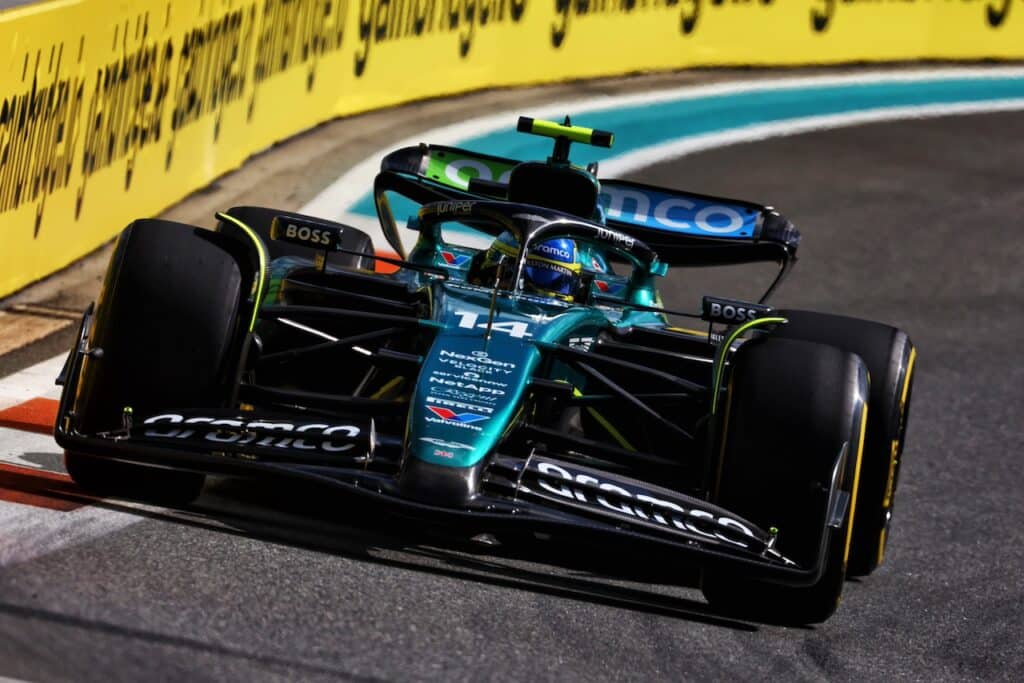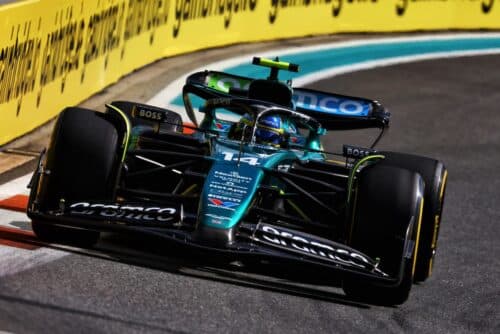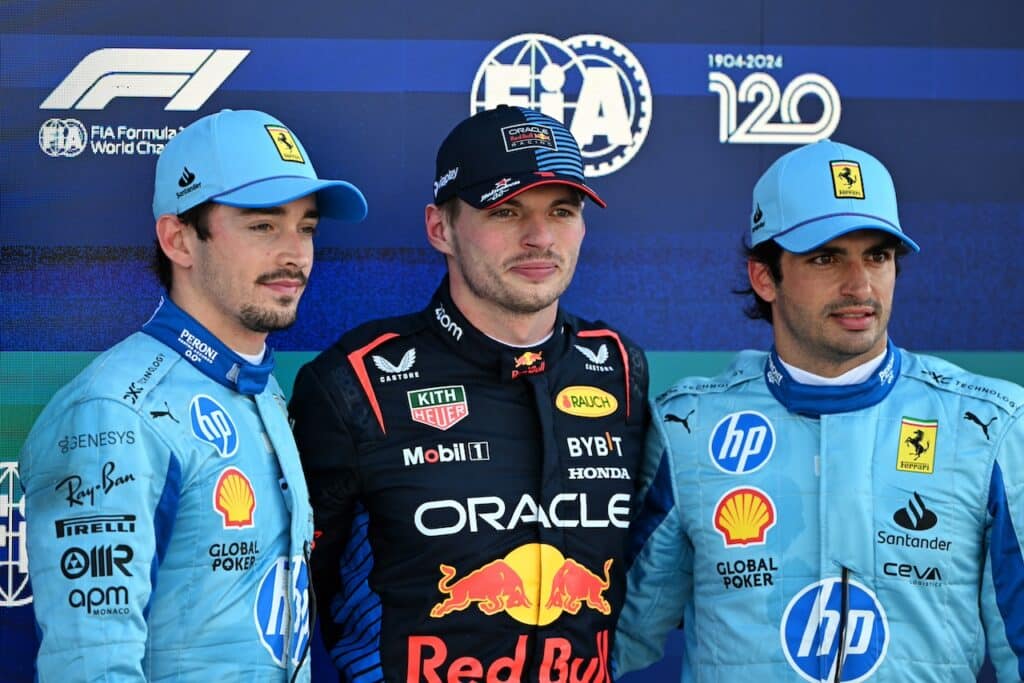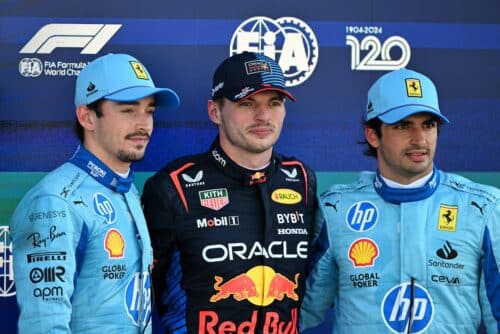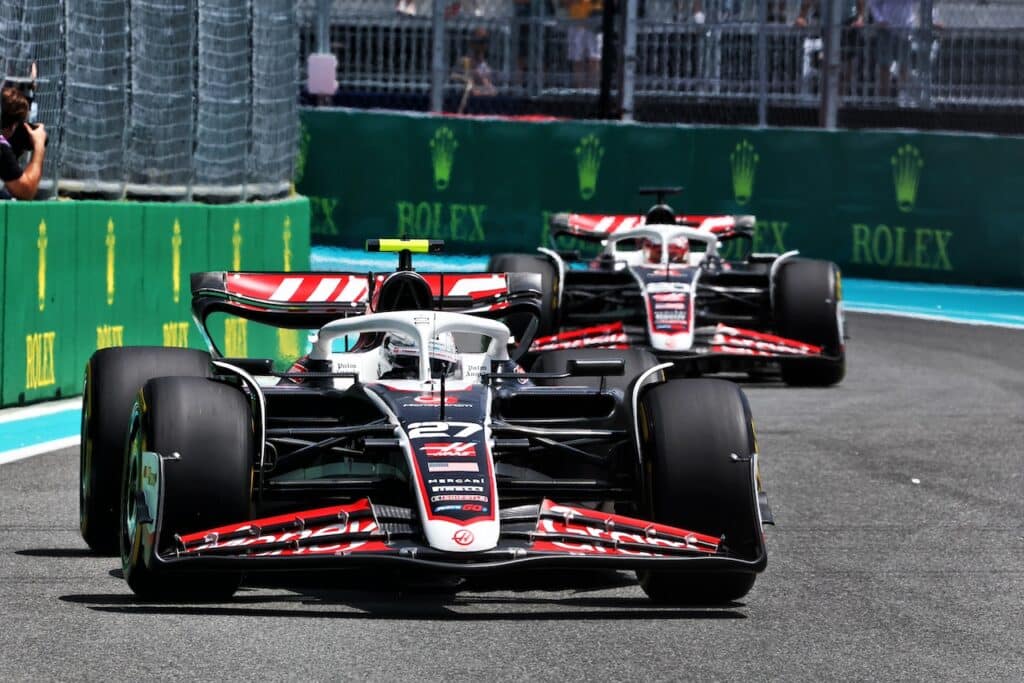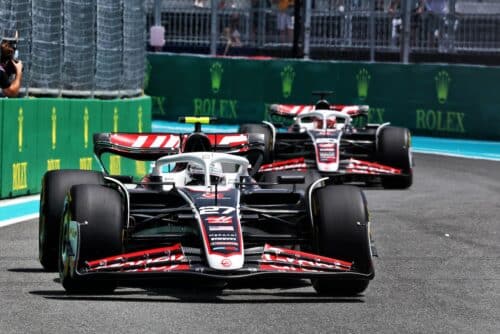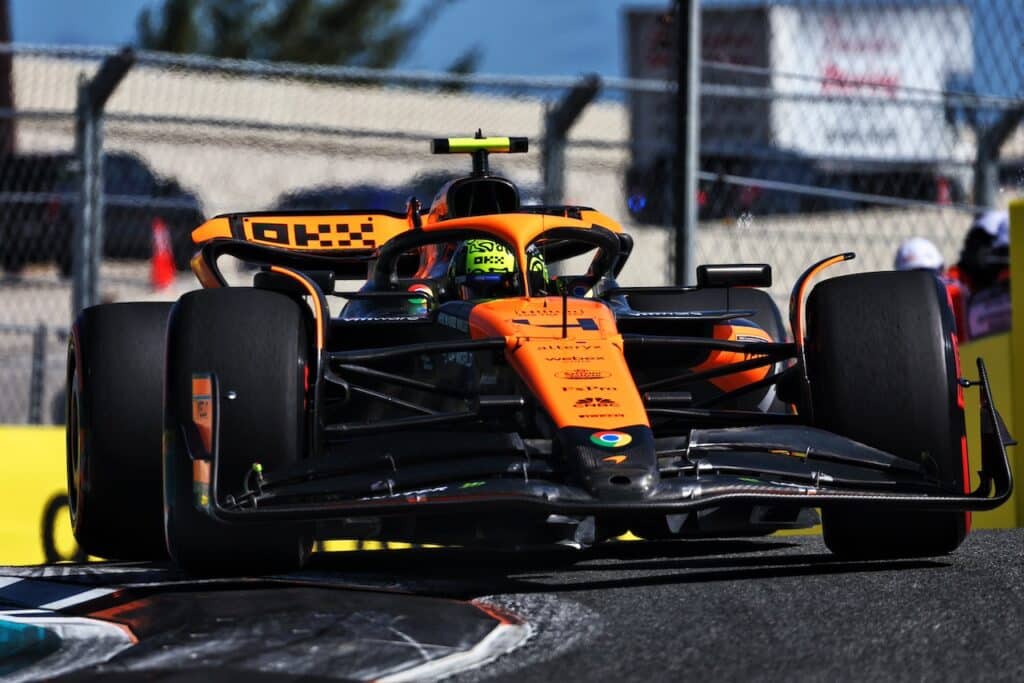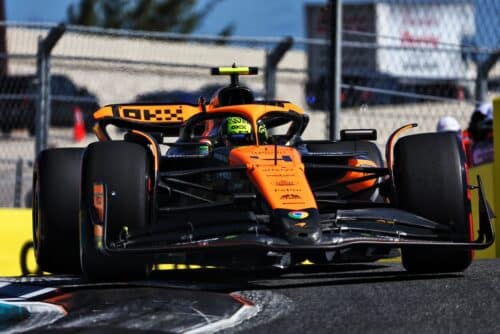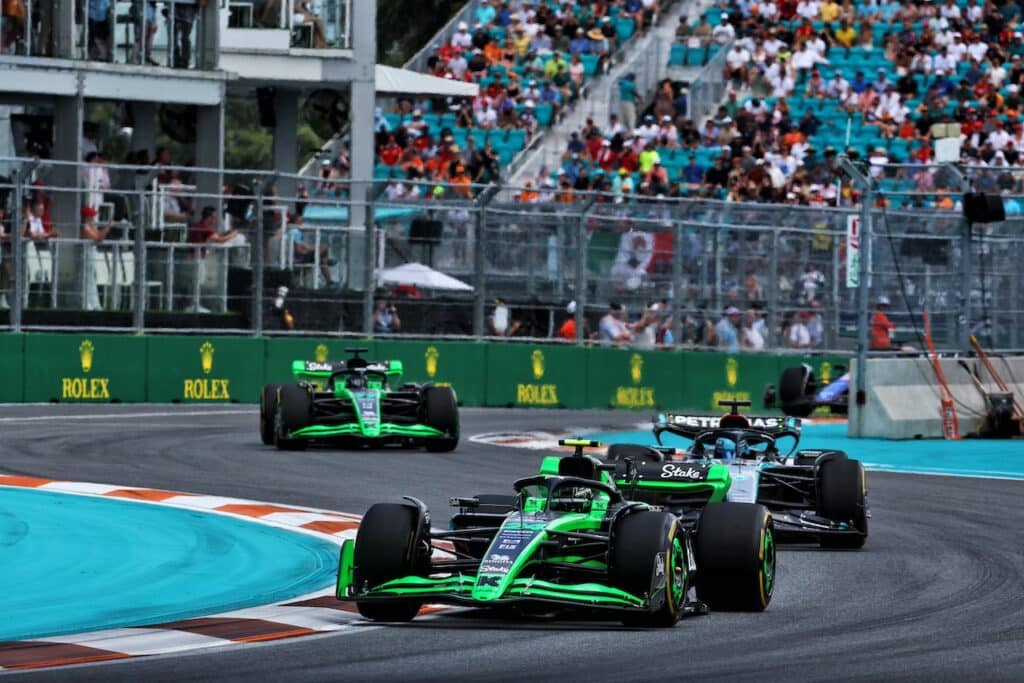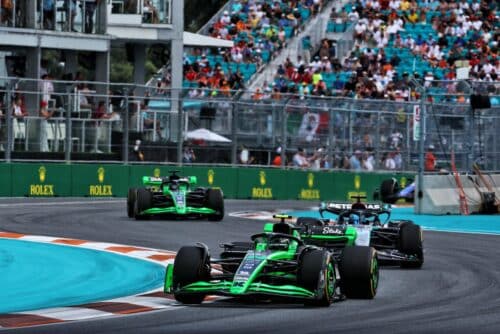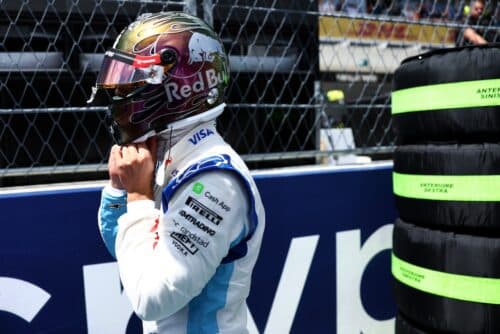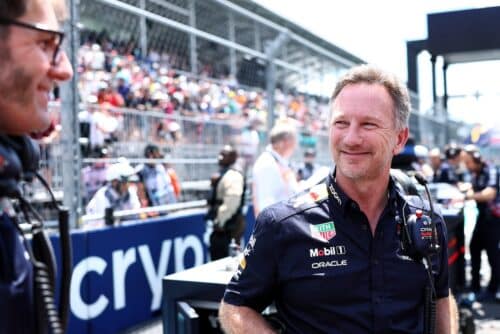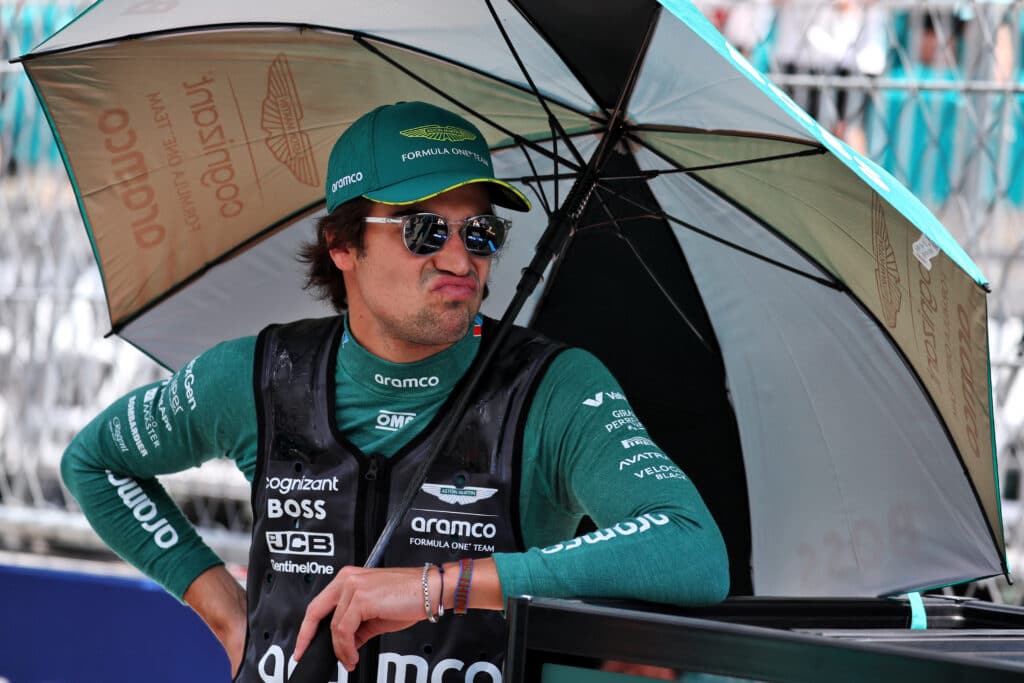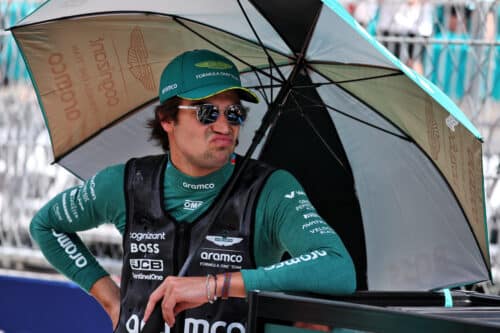F1 | Bahrain Grand Prix: analysis of the race
From Grosjean's accident to Hamilton's victory: the story of the Sakhir race
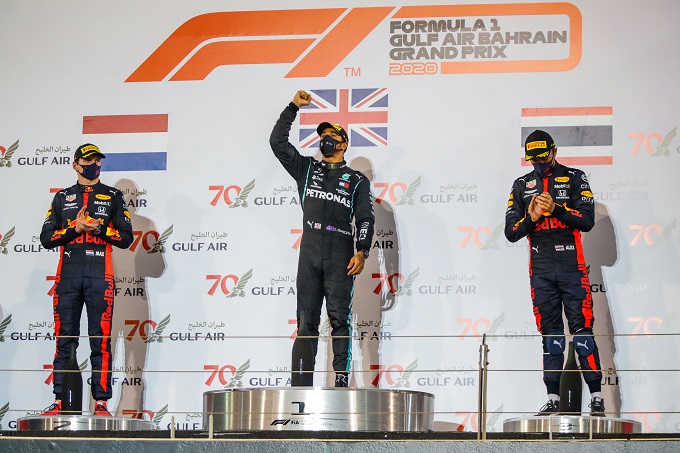
“I'm fine, I have hands like Mickey Mouse! The burns are superficial, I can move all my fingers. I never lost consciousness, I remember everything from beginning to end. To get out of the seat, I managed to remove the seat belts, the steering wheel was no longer there, it probably flew off during the impact. I saw my visor all orange, the flames around me, and I was reminded of Niki Lauda's accident, I didn't want to end up like this. I had to get out of there, for my children. In the end, I have burnt hands and a big sprain, I thought I broke my foot. I was more afraid for my relatives, my children first and foremost, but also my father and mother, than for me. I saw death coming, I had no choice but to get out.” He couldn't have started his analysis of the Bahrain Grand Prix differently, his theater despite a very bad accident during the first lap, which saw Romain Grosjean fighting between life and death. In the initial stages, in fact, a contact between the Frenchman and Daniil Kvyat caused the Haas driver to crash into the barriers at a speed of over 200 km/h with an impact of around 53G. In addition to the violence of the bang itself, however, what was worrying was the fact that the car had broken into two distinct parts immediately after the accident, starting a large fire in which the Frenchman himself could have been stuck. Fortunately, thanks to his quick reflexes, Grosjean had managed to get out of that hell in thirty seconds, only suffering a few burns on his hands and feet: a real relief thinking about what, in reality, could have happened. Other elements, however, had played a fundamental role, starting from the halo, which had prevented the Frenchman's head from impacting against the guard rail which had just been broken through, or the survival cell, which despite the numerous reported dents, had managed to carry out its task very well, protecting the pilot from a very violent impact.
The immediate intervention of the track staff and the Medical Car staff was also very important, as they arrived at the accident site in a very short time to help Romain get out of that hell. Looking carefully at the images, in fact, we can see how the use of the fire extinguisher in a certain sense protected the Frenchman at a time when Grosjean himself was trying to unbuckle himself and get out of the cockpit. Equally important were also the progress in terms of safety made by the Federation over the last few years, such as the introduction of the Hans, which had made it possible to reduce to a minimum the possibility of the Frenchman losing consciousness following the strong deceleration, keeping him conscious all the time, or the new suits designed to have longer-lasting protection against flames, tested last season by Kimi Raikkonen in the Abu Dhabi tests, or the seat belt release system, specifically designed to facilitate pilots on occasions like these. There are many factors that played a decisive role, protecting Grosjean from a fate that could have been very different from what we witnessed. Given the seriousness of the accident, the Federation then decided to open a more in-depth investigation, in order to understand the causes that led in particular to the outbreak of the fire, something which had not been seen for years. There are various hypotheses, such as a fuel leak from the pipes that carried the liquid from the tank to the engine, or something related to the battery.
A key role was certainly played by the fact that the car had broken in the anchoring points between the survival cell and the rest of the single-seater, something which is quite rare, but which the FIA will certainly investigate thoroughly to understand how to improve it. the security. Still observing the images, we can also see how the tank actually remained sealed and this was very important, because with around 105kg of fuel, the chances that the fire could become even more catastrophic were really only a step away, but the progress completed in this respect have clearly guaranteed a good level of safety. A different matter is that regarding the barriers, which then sparked several controversies: clearly no one expected an accident in that area of the track, especially with that angle and at those speeds, so an attempt was probably made to contain costs by positioning guards rails, which also facilitated the entry of emergency vehicles. At the same time, clearly, it was not even easy to find a definitive solution, because on the one hand it is true that the barriers had to absorb the blow, but on the other they also had to avoid "bouncing" the car and sending it back onto the track. In this respect, for the second round in Bahrain some rows of tires will be installed to try to better absorb the impact but, hopefully, for next year the circuit staff will intervene by installing a more suitable and definitive solution.
Regarding the news of the Grand Prix, the winner once again was Lewis Hamilton, author of a downhill race after two excellent starts, in which he was able to best manage all the various challenges of the race, thus taking home eleventh seasonal success. One of his toughest rivals in this championship, Max Verstappen, finished behind him and tried his hardest to try to stop the Englishman from winning yet another victory, but had to give in to a difference in performance between the two single-seaters. subtle but still noticeable. On the third step of the podium Alex Albon made his appearance for the second time in his career, although beyond the good result, there is certainly something to review as this conclusion was reached above all thanks to the withdrawal of his closest opponent a few laps from the end. In fact, it was Sergio Perez who paid the price, who after a race at very high levels was forced to retire due to a technical problem on his single-seater. A real shame, because the Mexican would have deserved this result for what he showed on the track, where his tire management was once again sublime.
Fourth and fifth place for the two McLarens of Lando Norris and Carlos Sainz Jr., with the latter protagonist of an excellent comeback after the breakdown that occurred in qualifying. Sixth place for an amazing Pierre Gasly, who was good at making his single-stop strategy work as best as possible and was able to counterattack his opponents. Finishing in the points were the two Renaults of Daniel Riccairdo and Esteban Ocon, Valtteri Bottas and Charles Leclerc. A rather complicated race for the Finn, complicated by a bad start and a puncture in the very first stages, factors that had forced him to perform a comeback performance.
Mercedes: a two-sided race
Given the characteristics of the track, on the eve of the third to last round of the world championship, Mercedes started with the predictions in favour. On a track that rewards the skills of the Power Unit and good tire management, undoubtedly the German team would have been able to best express the potential of its W11, repeating the success of Turkey which had allowed Lewis Hamilton to win his seventh iridescent laurel. The entire front row conquered on Saturday had laid the foundations for a one-two which, although difficult to achieve given a possible inclusion by Verstappen, was within reach.
Already at the first departure, however, something had changed. Since Friday it was clear that starting on the right side of the grid, the dirty one, could have clearly compromised the starting position, risking losing numerous positions which would then have been difficult to recover. It was above all Valtteri Bottas who suffered, who despite himself was the protagonist of a terrible start when the traffic lights were turned off due to excessive slippage of the rear tires from the second spot on the grid, thus seeing himself passed by not only by the two Red Bulls, but also by Sergio Perez and Daniel Ricciardo before the red flag was displayed. Fortunately for the Finn, the race directors' decision to form a new grid based on the "Safety Car Line 2" positions had given him the opportunity to limit the damage and only lose two positions on the grid, namely those to Max Verstappen and the Mexican from Racing Point, which would have meant starting from fourth place. Problems that, however, Lewis Hamilton, author of one of his best shots of the season, did not have, so much so as to surprise the driver himself, as he hinted during a brief debrief with the engineers during the break due to the neutralization of the race.
At the restart, therefore, Lewis would once again line up from pole position, while his teammate would start from fourth place, hoping to be able to recover in the very first meters of the race, so as not to get stuck in traffic and let the most direct rivals. As had happened previously, even in the second start Hamilton was able to skilfully maintain the lead of the race, laying the foundations for what could have been yet another success, while Bottas, also in this case, was not the author of the sprint particularly brilliant, however managing to maintain fourth position. The entry of the Safety Car onto the track had once again neutralized the situation, allowing the drivers not only to save their tires on a track with a very aggressive asphalt on the covers, but also fuel, given that Sakhir is among the most demanding tracks of the world from this point of view. Precisely at this juncture, however, the races of the two standard bearers of the Stuttgart team would have taken completely different paths: on the one hand Hamilton would have remained firmly at the top of the standings, while on the other Bottas would have slipped to the back of the group due to a puncture .
The Englishman's race was undoubtedly the less eventful of the two, as he remained in the lead essentially for the entire race. A success also built thanks to an excellent restart after the Safety Car, in which he was able to find the perfect moment to surprise his rivals and quickly gain a minimum advantage of almost two seconds which would have protected him from a possible use of the DRS of the drivers behind them. A small but substantial treasure that had allowed him to set up his race differently, taking care from the very first laps to safeguard the tires and fuel, two particularly critical aspects in Bahrain, despite the neutralization period behind the safety car having allowed him to contain the consumption. In the direct comparison with his closest rival, in fact, Hamilton only lost in the most demanding and stressful corners for the tyres, such as turn six and turn 12. The excellent management of the coverings had allowed the pit wall to think about strategies with greater confidence, given that, at least before the race, the fact that Red Bull had kept two new sets of hard tires could have proved to be a significant advantage for the Anglo-Austrian team, especially if tire wear had turned out to be greater than expected waited.
A turning point, however, came during the nineteenth lap, when Mercedes decided to recall its top driver to fit the only set of hard tires available, essentially changing what could have been the history of the race. A choice that seemed to have arrived a bit suddenly, given that in the previous laps it seemed that the wall's idea was to continue to extend, but which had come precisely in the lap in which Lewis had started to complain about the rear tires , not so much for their wear, but for the fact that they were starting to overheat, decreasing the total grip available. As confirmed by a subsequent radio team, in fact, at the time of the stop the tires mounted on car number 44 were around 70% of their potential, so much so that, despite the small problems reported, Lewis' idea would have been to continue. The decision, however, also had to be seen in a broader context, taking into account what Red Bull's choices could have been. During the eighteenth lap, in fact, Verstappen had been the protagonist of a long turn in turn ten, which had cost him around a second in a moment of general difficulty, thus bringing the overall gap to around five seconds. To make up for the time lost in that situation and contain the loss of pace that had been recorded in the last few laps, it would not have been impossible to imagine an early reaction from the Anglo-Austrian team, taking advantage of the new tire to quickly get closer and get back into the game with tires already at temperature. For this reason, the Mercedes wall had decided to take precautions, making the move and calling its color holder to the pits to mount the second set of medium tires available, unlike Verstappen, who would then return on the following lap to fit a set of hard tyres, which would have allowed him to push without paying too much attention to their wear.
At the beginning of the second stint, in fact, Max had pressed on the accelerator, imposing a really interesting pace even at the cost of temporarily sacrificing tire management, so as to be able to reduce the gap and get back to around four seconds, a still useful gap to be able to think about attempting a second early stop and get even closer. On the contrary, Lewis had tried to manage his tires in a more cautious way, well aware that the main objective would be to make the average last as long as possible, so as to be able to then make the final stop and move on to The only set of hard compound tires available to the Englishman. An approach that had borne fruit not so much immediately, but over the long distance, so much so that despite some traffic at the home of the lapped cars, around the thirty-third lap Lewis had managed to bring his lead back to almost six seconds. Unlike the first phase of the race, however, in this second stint it was Red Bull who decided to make the first move, calling Verstappen back to the pits to mount the second set of hard tires available, probably driven by the fact that Hamilton would have could have stopped shortly to avoid a large group of lapped drivers.
At that point, well aware that they would end up using the same strategy as their rivals and that they could take advantage of their rivals' slow pit stops, the most logical choice for Mercedes was simply to go and cover their rivals' moves, recalling Lewis the following lap in order to be safe and try to bring the car to the finish line in first position. As we had seen previously, at the start of the stint Verstappen had once again been very aggressive on the tyres, trying to close the gap to the tread, which had in fact been reduced to just three and a half seconds, while Hamilton had once again concentrated once on trying to manage the tires as best as possible, so that they were still in good condition in the closing stages of the Grand Prix. Also in this case, the more cautious approach of the Englishman had paid off after a few laps, starting to gain steadily until he put a gap between himself and the Dutchman behind him which would have allowed him to easily cross the finish line in first position. A continuous gain that had pushed Red Bull to change strategy, thus stopping for the third time in the hope that the last set of medium tires would allow them to get closer and take advantage of the opportunity in the event of the Safety Car's entry. A plan that in itself could have made sense, because by entering the "window" of the seven-time world champion, they would have put the team in the situation of having to choose between maintaining the track position but with worn tyres, or calling their team to the pits. bearers aware that, however, he would have returned to the track right behind the Red Bull driver, thus having to try to overtake on the track. Fortunately for Hamilton, despite the entry of the safety car in the final laps, the Anglo-Austrian team's plan had not had the desired success, thus giving the Stevenage driver the opportunity to take the checkered flag once again in front of everyone and conquer his eleventh success of the season.
The race of his teammate, Valtteri Bottas, was much more complex, only eighth at the finish line after a comeback race. The puncture that occurred in the first laps, most likely due to some debris in the area of Romain Grosjean's accident, had sent the Finnish driver back to the back of the group, thus being forced to completely change his plans and strategies for the rest of the Grand Prix. Award. An unexpected situation which, clearly, Mercedes had not foreseen and which brought with it numerous problems. First of all, it is important to mention the fact that the German team had set its cars for a race in open air or, in any case, in front of everyone, in which tire management would have made the difference compared to its closest rivals. For this reason, in choosing the set-up, keeping in mind the minimal but important advantage in engine terms compared to the competition, the "Stella" engineers had opted for slightly more loaded wings, which would have been penalized in terms of maximum speed. , but it would have given him a big hand in managing the tires and making a difference over the long distance.
Clearly, however, this choice would have proved detrimental if one of the two drivers had been forced to recover from the back, as the lack of top speed on the straights could have affected the W11's ability to overtake and help the team's standard bearers. to return to the top positions. After the restart, in fact, the Finn had remained stuck in a small group of drivers who were providing each other with slipstream and, not being able to count on the help of the DRS, with the deficit in terms of top speed it would have been even more complicated to be able to overtake opponents quickly. As if that wasn't enough, there was another problem that the German team would have to take into account: having set the car to race in free air, it was clear that remaining in the middle of the group would also increase the temperatures of the Power Unit and the brakes, with the latter starting to show numerous warning signs for overheating on the steering wheel dashboard after a couple of passes. A problem to take into account and which had pushed the engineers to ask their standard bearer several times to carry out actions that could reduce the temperatures: this was especially reflected in braking, where on several occasions Bottas had been forced to raise the temperature early the foot off the accelerator and carry out lift and coast manoeuvres, which affected the possibilities of braking and completing overtaking. Aspects which in the first stages had significantly influenced the race of number 77, who was thus forced to wait for the Federation's permission to use the mobile wing to start moving from the bottom of the rankings, completing in a short time two overtaking Vettel and Latifi.
Being able to get rid of the drivers in front of him as quickly as possible would have been vital for the Finn, not only because the time lost behind slower cars would have been significantly felt on the clock, but also because by remaining in the slipstream for so long of rivals, its hard tires would also have been affected, for which the Mercedes pit wall had predicted a long first stint with nineteen passes more than what would have been the initial target. Having arrived behind Raikkonen, being able to overtake his compatriot would not have been easy because, like Valtteri, Kimi could also benefit from the help of the DRS being less than a second from the car in front of him. This had forced the representative of the Stuttgart team to take several laps behind the Alfa Romeo number 7, at least until the latter was called to the pits during the seventeenth lap. An essentially identical argument could also be made for George Russell, who was good at defending himself admirably until the moment of his first stop, which had thus given Bottas the opportunity to finally find himself in free air and start pushing. It was no coincidence that, having freed himself from the traffic, the Finn's times immediately improved by over a second, maintaining a pace that would have allowed him to quickly close the gap on Charles Leclerc, who found himself at the presses with great difficulty in managing the tyres, so much so as to clearly facilitate the work of the Mercedes driver when overtaking. All the time lost behind his rivals in the first twenty laps of the race, however, had made itself felt on his tyres, which had begun to suffer a certain deterioration which would not have allowed the Finn to push as he would have liked, a fundamental aspect for trying to complete his comeback. The objective of the wall, in fact, was to attempt an overcut against those riders with whom he had previously battled, such as Russell, Kvyat and Leclerc. Unfortunately, that drop in tires combined with the fact that their rivals had been able to fit new sets, obtaining maximum performance, meant that it was very complicated for the German team to be able to stop Bottas and get him out in front again, as was then the case. actually verified.
With still a long race ahead of him after the pit stop, it was vital for Valtteri to be able to get rid of the traffic quickly, which happened in just a few laps, thanks to overtaking first on the English Williams and then on the Monegasque Ferrari. Considering all the time lost in the first part of the race, achieving the podium or fourth place would have been almost an impossible feat, but Renault's objective was within reach and, with a bit of luck, it could have been too. catch up again at least one of the two McLarens, albeit more distant, as Mercedes itself had come to imagine in its real time simulations. A possibility also confirmed by the fact that in that moment of the race, Bottas was setting times absolutely comparable to those of the leading two, a sign that with the track clear the number 77 actually had the pace to remain there in front and compete with his teammate. team on a track where he has generally always felt at ease. To catch up with the French team's two single-seaters, however, it would have been vital to overtake Pierre Gasly as soon as possible, who was on a completely different strategy from his rivals, having set up his race on a single-stop tactic. . Valtteri had managed to close the gap to the French driver rather quickly, but being able to overtake him would have been a completely different story. Since free practice it had been possible to notice how the AlphaTauri could enjoy excellent top speeds and, keeping in mind that the W11 number 77 was guilty of this point of view despite the use of DRS, it was easy to understand why Bottas had remained stuck behind him for several steps, unable to find the right opening to complete the maneuver. This, naturally, had a clear impact on the Finn's pace, forcing the wall to bring forward the third stop, also to respond to the two Renaults that had stopped only a couple of laps earlier.
A decision that had to be put into the right perspective for the Mercedes garage: first of all, it would have been very complicated to get to the checkered flag on the set of yellow band tires that it was putting on at that moment, which already had about fifteen passes behind it , so another stop would definitely be necessary. Secondly, it was essential to keep in mind what the alternatives might have been for the Finnish. Undoubtedly the German wall could have extended the stint for a few more laps, hoping to be able to quickly overtake Gasly and then fit a set of soft tires for the final stretch, which with Sainz had given more than positive results even over the long distance. By remaining behind the French driver for so long, however, the risk of not being able to complete the overtaking in a short time and the fact that the two Renaults could have exploited the moment to virtually increase their advantage meant that for the team Stuttgart had no choice but to recall its standard bearer in advance of what would have been the ideal timetable.
It goes without saying that this wasn't even the decision the team would have wanted to make, also because there was a very important detail to keep in mind: bringing the stop forward would have meant being practically forced to fit another set of medium band tyres, not so much because the soft would not have reached the end, but because at the end, having covered so many laps, it would not have given that little bit more in terms of grip to be able to attack the rivals. The problem arose when the only other set of yellow stripe tires available was the one with which he had suffered a puncture at the start of the race, effectively rendering the right front tire unusable. For this reason it would have been essential to extend the second stint as much as possible, but finding ourselves in a situation with no alternatives, the only option on the table for the wall was to recall Bottas and replace three out of four tyres, in the hope that the front right could hold for a total of almost thirty rounds. A move which, although unusual, was perfectly compliant with the regulation, specifically with article 24.2 a), which states: "A complete set of tires will include two front tires and two rear tyres, which must be of the same specification and as allocated by the FIA although, however, sets of the same specification may be mixed after the qualifying session.”
With almost twenty laps available, the hunt for the two Renaults was on. A gap of around four seconds separated him from Ocon, while it would have been more complicated to catch Ricciardo, who was around six seconds away. The overtaking on the Frenchman had not been that difficult to achieve, having managed to close the gap in just a few steps, but the same could not be said for the Australian, who in the last few steps had managed to maintain an excellent pace, thus making it was difficult for the Finn to get close before the checkered flag. The introduction of the Safety Car due to Sergio Perez's retirement had then taken away any chance for the Finn to be able to progress in his comeback, thus having to settle for eighth place in the finish. A very complicated race, in which very little went right, from the slow start, through the puncture in the first laps, to the difficulties in completing overtaking due to a set-up designed for different conditions. His race could be summed up in the final prank a few laps from the end, when his car was once again found to have a puncture in the right rear tyre, even though the fact that he was behind the safety car had allowed him to reach the finish line without further pit stops.
Red Bull: everything for everything
After the setback in Turkey, due more to errors by the drivers and the team than to a real lack of pace of the car, in Bahrain Red Bull was looking for redemption. Being able to take home the stage success would have been extremely difficult, given that on the Sakhir track the skills of the Power Unit can make the difference, but being able to at least get between the two Mercedes cars could have been an attainable objective.
The third place achieved on Saturday was undoubtedly a starting point for achieving this result, especially since Max Verstappen would have started from the clean side of the grid, which would have had its benefits when releasing the clutch. So it had been and, also taking advantage of Bottas' uncertainty in the initial stages, the Dutchman had managed to quickly move into second position at Safety Car Line 2, enough to keep it even after the red flag. Although undoubtedly the front row on the grid could represent a point in favor in the chase for a place on the podium, it would have been essential for the Red Bull driver to get the start right and not be the protagonist of a negative start like that of the driver previously. Finnish. From this point of view, the Dutchman had completed a good job limiting rear skidding as much as possible, although Perez still managed to come alongside when braking into turn 1. It was precisely at this point that a good part of the Red driver's race passed. bull, as finishing behind the Racing Point rival would not only have given Hamilton the opportunity to escape and build a lead that would be difficult to close later, but would also have left the door open to a possible attack by Valtteri Bottas, who started from fourth position on the grid.
Thanks to a very deep and aggressive braking in turn 1, Verstappen was able to stem the Mexican's attack and maintain second position before the entry of the safety car neutralized the situation again. This had given the Red Bull driver the opportunity to put himself once again in a situation in which he could have approached his Mercedes rival and attempted to overtake on the restart, even if this would have required not only a lot of engine power as he could not use the DRS, but also a good starting point, something that the Dutchman had actually lacked, given that Hamilton had managed to take those behind him by surprise and immediately gain a minimal but precious advantage.
Although he was doing his best to limit the gap from the tread, even at the cost of sacrificing the life of the tires by making less saving in some of the most demanding areas of the track, this continued to grow lap after lap, until it reached around four seconds. An error by the Dutchman at the exit of turn ten had done nothing but make the situation even more complicated, bringing the gap to around five seconds, even if Max had cleverly managed to limit the damage, accelerating and covering a stretch on the outside of the track, so you don't have to slow down for the curb and get back on the track immediately. Thanks to the small advantage available and the possibility that Red Bull could actually recall its standard bearer early to try to reduce the gap, Mercedes had decided to change the cards on the table and make the first move, thus recalling Hamilton to the pits to fit an additional set of medium compound tyres. The only alternative in Red Bull's hands at that point was to follow their rivals, thus stopping Verstappen: unlike the Englishman, however, a new set of hard tires had been fitted to the Dutchman's car, as the team he had managed to save two from previous sessions. This clearly, if the hard had turned out to be a competitive compound, could have given the standard bearer of the Milton Keynes team an advantage, allowing him to save less and be able to push more over long distances. An aspect that Verstappen had fully grasped, pushing as much as possible in the first laps after the stop, which had allowed him to reduce the gap to around four seconds, at least before the situation was reversed and he was once again the seven-time world champion to dictate the pace and make money. The second stint didn't offer any particular shocks from this point of view, with the two carrying out a sort of rubber band marking each other, waiting to understand what would be the ideal moment to make the second and final pit stop.
There were essentially two options in Red Bull's hands. On the one hand, trying to go as long as possible in the hope of being able to fit a set of soft tires for the final assault in the last part of the race, which clearly however could have clashed with the fact that, by fitting a medium tyre, Hamilton most likely would not have continued on for much longer, thus risking building a useful treasure to defend himself in the fight for victory. On the other hand, there was the opportunity to do exactly the opposite, i.e. understand when the Stevenage driver would stop and anticipate it, thus trying to make a difference in the phases immediately following the stop. From this point of view, the radio communications from the Englishman had probably also been fundamental, as a couple of people returning before the pit stop had started to notice strange vibrations on their tyres, a phenomenon that was not entirely new for the German team. Despite the various alternatives available, Red Bull had decided to go on the attack, bringing forward the second stop in the hope of being able to get closer to the pacesetter. A plan that could have worked if it hadn't been for one of the rare errors on the part of the Red Bull crew in charge of the pit stops, forced to extend the tire change by a few, but fundamental, seconds. Taking advantage of this unexpected event, the pressure on the leading Mercedes was naturally reduced, having a wider margin to manage which would not even require pushing excessively after the stop, thus safeguarding the covers. In order not to take any risks, however, the German team had done nothing other than cover their rivals' move, recalling Lewis in order to essentially put him on the exact same strategy as the one behind him. As we had seen previously, however, after a few rounds of attack Verstappen began to suffer again on his times, progressively increasing his gap from what could have been the fight for stage success.
With now few strings in their bow to turn the situation around, there was nothing to lose and only one factor could have changed the fate of the Grand Prix, namely a possible entry of the Safety Car. Precisely for this reason the Red Bull wall had decided to go all out, once again calling its driver back to the pits about ten laps from the checkered flag in the hope that, by returning to the window of the rival Mercedes, a possible entry of the safety car could send the German team into crisis. In that case there would have been two alternatives for the team directed by Toto Wolff: to stay out, but with a set of hard tyres, which undoubtedly would have guaranteed less grip over the long distance, or to stop and fit a set of soft tyres, thus losing the track position. A move which, however, had not worked essentially for two reasons: on the one hand the fact that after the break Verstappen had lost some time behind a group of lapped drivers, thus missing the Englishman's window for only a few seconds, on the another was the decision by the race management to keep the safety car on the track until the checkered flag, thus depriving all the drivers of the opportunity to attempt a final attack.
The race of the other Red Bull driver, Alex Albon, was much more "linear", as he achieved his second podium of the season thanks also to the withdrawal of his closest rival, Sergio Perez, in his quest for third place. The fourth place achieved in qualifying represented an excellent starting point for being able to confirm himself in the race, avoiding the traffic that very often made the two races much more complicated. Unfortunately, as with Bottas, the Anglo-Thai driver had also been the protagonist of a slow sprint when the traffic lights went out, immediately losing position to Sergio Perez, who had instead started from the clean side of the grid, thus seeing himself slip in fifth place for the restart. Even in this situation, however, he was not the protagonist of a particularly convincing sprint, thus remaining behind what would have been his closest rival in the fight for the podium, Perez. The puncture that occurred on car number 77, in fact, had left the door open to an unexpected result, which would have required a high-level performance. A rather interesting point of the Red Bull rider's race concerned the first stop, which was rather questionable from several points of view. Not only at that moment there was no extreme need to stop, but above all by waiting two more laps Albon would have managed to free himself from Leclerc's traffic, having more concrete chances of getting closer to the Mexican. One wonders if, as happened on other occasions, the Anglo-Thai team had used its driver to understand the behavior of the harder tires, while waiting to mount them on Max Verstappen's car for his second stint. During the second phase of the race, Alex had managed to maintain a pace almost similar to that of his closest rival, but not enough to be able to get back into his exhausts, so much so that around the thirtieth lap this stood at around five seconds. Naturally, at that point the only alternative available to the team was to play in advance, imposing itself on the strategies and recalling its Bishop, in the hope that that extra lap on new tires would allow it to get closer and get to a minimum distance to then attempt an attack. A tactic that had worked, also considering the difficulties that the Racing Point Mexican had encountered in overtaking Carlos Sainz Jr. after his stop, thus decreasing the gap to just over two and a half seconds, enough to make an extra leap in terms of performance and take advantage of the use of DRS. Unfortunately, however, just as in the second stint Perez was able to impose his own pace, a few tenths faster than the Anglo-Thai driver, until he put himself in a safe situation.
Racing Point: a podium (literally) in smoke
Over the last few weeks, Racing Point has proven to be one of the most competitive teams on the track, fighting several times to reach fourth place – or even the podium – as the top team in the midfield. The second position achieved in Turkey had best represented the form of the Anglo-Canadian team, which was ready to repeat itself in Bahrain, in particular with Sergio Perez, who has always been a skilled interpreter of the Sakhir track, where the management of the rear tires represents a fundamental aspect.
The fifth place achieved in qualifying undoubtedly represented a good starting point to aim for another important result, particularly if someone in front of him had suffered problems. The excellent start from the clean side of the grid had immediately allowed him to recover the position not only from Alex Albon, but also from Valtteri Bottas, who had been the protagonist of a slow start despite himself. The neutralization of the race due to the red flag had thus provided the opportunity to take stock of the strategy and how this would affect the long distance, with the aim of managing those behind him and making the most of the situation. At the restart, the Mexican was once again the author of an excellent clutch release, quickly moving alongside Max Verstappen, but without really sinking the braking into turn 1, as the Dutchman had instead done in a particularly aggressive move. A wise choice by the Racing Point driver who, being on the clean side, could also have dared something more in braking, but the risk of finishing long and compromising his race for a position that he would most likely have struggled to maintain in the rest of the Grand Prix, was too high. Also following the puncture suffered by the Mercedes number 77, the podium seemed an increasingly within reach goal and, to be able to achieve this result, it would have been essential to be able to maintain a high level pace, managing the tires as best as possible.
Thanks to the numerous passes completed behind the safety car, the pit wall had had the opportunity to consider his available alternatives, opting to remain on "plan A" but extending the stint by at least four laps, in the hope of making the I work on the other sets. For the entire first stint, the Mexican had maintained a comparable pace to his rival, only a few tenths faster, but enough to be able to build a small gap that would have protected him even in the event of an early stop, as in fact had happened. verified. The Red Bull wall, in fact, had decided to call its standard bearer back to the pits, thus putting Racing Point in a situation of having to make a decision and react, which is why the Anglo-Canadian team had also decided to stop the Mexican in the next step. Clearly both had not benefited from this, having ended up in the traffic of both Carlos Sainz Jr. and Pierre Gasly, although Perez had been incisive in completing overtaking and freeing himself from that difficult situation. The most important aspect was to be able to maintain a constant pace while managing the tires over long distances, which is why the track engineer had advised him to push in the high-speed corners and to manage in the faster sections, such as turn 12, where the loads on the tires were higher. From this point of view, Sergio had done an excellent job and at the end of the stint his advantage over the driver behind him had increased to around six seconds, which would have protected him from a possible undercut attempt.
Once the final pit stop was completed, even in the third and final phase of the race the instructions on the wall remained the same, in which the number 11 was asked to manage the tires and use them only in the low speed areas, where the loads transmitted were lower . The Mexican driver's performances remained identical, thanks to which he was able to gain tenths after tenths over his rival. Only a drop in power at the end prevented him from achieving a third place which he undoubtedly deserved, thus forcing him to park his car on the side of the track. By checking the telemetry, we can see how the Power Unit's performance when exiting the corners was the same compared to the laps in which the problem had not occurred, a sign that the fault could be more on the electrical part than the endothermic one. According to the team's initial analyses, it was the MGU-K that failed, although further inspections will be essential regarding the units that will be sent back to the engine manufacturer's headquarters in England.
A truly difficult ending to digest, not only for Perez, but also for the team, which had thus been forced to give up important points in what would have been the fight for third place in the constructors' championship. In addition to the withdrawal of the Mexican, in fact, there was also the zero of Lance Stroll, the protagonist of a bad accident during the first lap after the interruption due to the red flag.
Gasly fits in between McLaren and Renault
The Anglo-Canadian team's bad day had a major impact on the constructors' standings, with a zero which gave McLaren the chance to extend their lead thanks to a fourth and fifth place achieved by taking advantage of all the situations in the race.
If Lando Norris's race didn't have any particular shocks, being too slow to be able to keep up with the pace of Sergio Perez and Alex Albon, but fast enough to protect himself from the two Renaults, Carlos Sainz Jr's race was much more interesting ., author of a completely different strategy compared to that of his opponents. After the fifteenth position achieved in qualifying due to a technical problem on its car, it was clear that the English team had to do something different and act by taking its rivals off guard. Precisely for this reason, the team had decided to start the Spaniard on the soft tyre, the softest compound available in the entire range brought by Pirelli to Bahrain, which had allowed him to recover two positions before the red flag was shown. That small step forward on the grid would have allowed him to get back into the fight for the points, but at that point it was fair to ask what strategy the team would have chosen given the opportunity of having already cleared one of the two compounds. As with Pierre Gasly, a single-stop tactic would not have been impossible, but it would clearly not have been easy to make it work. Following what was decided before the neutralization, the team's choice once again fell on the soft, however with the awareness that in order to be able to recover useful positions in the standings it would be essential to be able to keep it alive for as long as possible. In this respect, managing to overtake Leclerc after very few laps and managing the soft tires for as long as possible had been the key move of his race, especially considering that his closest rivals, the Renaults, had stopped before him, frustrating thus their advantage in starting on the medium compound, which, on paper, should have provided greater resistance. Furthermore, it was the French who provided the perfect assist: during the seventeenth lap, in fact, when Carlos was behind Ocon, the team initially called him back to the pits, so as to be able to carry out an undercut towards the transalpine. However, when the Spaniard realized right at the end of the lap that Renault had also followed the same strategy, thus bringing forward the pit stop, Sainz had acted particularly intelligently, staying out. Naturally, Esteban would have had the opportunity to lengthen slightly with new tyres, but given that the pace of the driver from Madrid was still competitive and that there was the possibility of extending the stint by a few more laps, making the work on the subsequent ones less burdensome, why not to continue?
Considering that the two Renaults had also ended up in traffic, their chances of fully exploiting the performance boost given by the new tires had been considerably reduced, so much so that, in practice, after his pit stop Sainz had lost no more than a few second to its closest rivals. A situation that had guaranteed the possibility of momentarily resetting the situation and understanding what the alternatives were at their disposal: having no threats behind them, Carlos had used the first laps after the stop to slowly bring the tires up to temperature, that is, in a where excessive stress on the tires can be felt markedly over long distances. Only after a few laps did the Spaniard push again and, finally, within a few laps the overtaking he had sought in the first stint had arrived, namely those on Daniel Ricciardo and Esteban Ocon. A difference in performance given not only by the different compounds available (new medium for Sainz, new hard and used medium respectively for the two Renault drivers), but also by the excellent preparation of the driver from Madrid, who was thus able to get rid of in succession of two of his main rivals on the track.
With almost thirty laps still available, the Spaniard's objective was no longer to be satisfied with a sixth place, which would still have been excellent considering the starting position, but rather to catch up on his Scuderia teammate, who was only a few seconds later. The indications from the pits suggested that Carlos still had something to find in terms of performance and that he could better balance the phases in which to push with those in which to be more careful in tire management. Precisely for this reason the suggestions from the wall were to try to be a little more aggressive in turn 4 or turn 6, two sections where you can generally find a little bit of performance without impacting too much on the tires, but at the same time adopt more conservative management for example in turn 12, one of the fastest areas of the track where the loads are highest. This careful strategy, combined with the Safety Car and the fact that it had managed to extend the first stint on the soft without a too evident drop in timing, had allowed the English team to also extend the second phase of the race by around five laps, with the aim of also catching Pierre Gasly, who had planned his race for a single stop.
The fact that Norris had stopped a few laps earlier than his teammate had meant that it had essentially become almost impossible for Sainz to be able to close the gap on the Englishman again, with a gap that had gone from four to around ten seconds, to make it clear how much the new tire after a pit stop could actually make the difference on such an abrasive asphalt as that of Sakhir. However, Gasly's goal was within reach and, a few steps from the end, the Madrid driver managed to complete the overtaking thanks to a pace discrepancy clearly in favor of the Spaniard. The fifth place finish, which arrived thanks also to Perez's retirement, represents the right reward for a high level performance, both in terms of pace and tire management, thus allowing McLaren to gain an excellent haul of points for the constructors' classification .
A challenge from which, unfortunately, Renault now seems more distant, given the latest negative performances. The race in Turkey certainly had an important impact on the ambitions of the French team, considering, on the contrary, the good results obtained by both Racing Point and the English team, leaving the team directed by Cyril Abiteboul a bit at a standstill. A show of pride was therefore expected in Bahrain and right from free practice it seemed clear that, at least on the flying lap, Renault could actually have its say, despite the RP20 being considered the favorite on a track that is well suited to its characteristics . For this reason, the race performance of the two RS20s came almost as a sort of shock: not only was there not the pace to be able to keep up with Sergio Perez's exhausts, but not even to be able to finish in front of the two MCL35s.
From this point of view, the French team's move regarding Ocon's first pit stop was interesting, with which it had tried not only to defend itself from Sainz, author of a fantastic comeback, but also to attempt an undercut on Norris, who however, he had responded promptly by going out front anyway. The fact that the Frenchman had rejoined the traffic had clearly not helped Renault's strategy, which had thus wasted a good opportunity to exploit the medium tire and create an offset against the Spaniard from McLaren. During the second stint, the challenge was concentrated precisely on the duel against the driver from Madrid who, thanks to a difference in performance given by the different compounds, was able to overtake both RS20s in sequence, thus leaving the transalpine single-seaters to fight at the margins of the scoring area. The only shock was the internal struggle between the two, with Ricciardo managing to overtake Ocon during the second stint, who was clearly suffering with the tyres, thus moving up to seventh position. In fact, there was a difference between the two standard bearers of the Enston team in terms of the set available for the race: the Frenchman was left with only one set of hard tyres, so he would have had to complete two stints on medium, unlike the 'Australian, who had preserved both sets of white band covers, thus being able to exploit them to push for longer. This could be well appreciated over the long distance and the overtaking of the number 3 did not exactly come as a surprise.
More interesting, however, were the moves undertaken by the team to try to contain Pierre Gasly, who after his only stop, was able to quickly close the gap on Ocon and move into the attacking zone. The difference in pace between the two was very evident and for Renault, in order to try to save at least one position, the only alternative was to immediately recall its driver, having however to pay close attention to those drivers who potentially could have get back into his window, like Russell, who was right on the edge. Unfortunately for the Frenchman, only a few tenths had given the Englishman the opportunity to come out in front of him: although the counter-overtaking on the Williams standard-bearer had not required particular efforts, undoubtedly the time lost in that phase would have weighed on the result the final. Reasonably, the pit stop should also have come shortly for essentially the same reasons, but those two extra laps in which he remained on the track in the second stint meant that, despite having managed to complete the overtaking earlier, the Australian upon exiting the pits he found himself once again behind his teammate, thus having to start from scratch and build new opportunities. In this respect, Daniel had made the most of the first phases after the stop, pushing on the accelerator and putting on a great show in a good duel with the other RS20, which he had skilfully managed to overtake for a second time, thus giving himself the opportunity to take off and contain a possible attack by Valtteri Bottas, who was recovering rapidly after a first half of the race spent at the back. The excellent pace maintained up to that point on a compound that allowed one to push even for long periods had helped Ricciardo to contain the Finn's comeback, also thanks to the entry of the safety car at the end which had thus secured seventh place on the finish line, even if, on the contrary, it had deprived him of the opportunity to attempt to overtake Pierre Gasly, only a few seconds ahead. Much more complicated, however, was the last stint for the other Renault driver, who had not only been overtaken by the Mercedes driver himself, but who had also struggled to find the right balance on a compound which he had not had in the race. used before, unlike your teammate. If, in fact, Ocon had previously managed to maintain a pace similar to that of Ricciardo, the same could not be said for the final stint, in which the difficulties in finding the necessary grip and the time lost in the duel with Bottas had widened the gap between the two.
The one, however, who can be absolutely satisfied with Bahrain's performance under the spotlight is Pierre Gasly, who took sixth at the checkered flag thanks to a completely different strategy from that of his opponents. Eighth place on the grid had left a bit of a bad taste in the young Frenchman's mouth, not so much for the time obtained, which was still competitive, but for the fact that a few hundredths of a second would have allowed him to recover several positions on the starting grid, thus simplifying your chances of obtaining a good result. Starting from the dirty side of the grid, like other drivers, Gasly also encountered excessive slippage, immediately losing position to Norris, who however managed to recover immediately in Turn 1, taking advantage of a more internal line which allowed him to even overtake Ocon. Unfortunately, however, these overtakings had come after Safety Car Line 2, which is why, despite the track saying something different, the Frenchman would have been forced to start from ninth place. Right during the red flag, however, something had changed and AlphaTauri's strategy had taken a different direction. Those few meters covered on average, in fact, had given the opportunity to "clear" one of the two compounds, so it would have been possible to attempt to complete the race on a single stop with two sets of hard tyres, which the Frenchman had wisely recommended after free practice in case the degradation proved excessive. On a track like Sakhir, it was clearly a very risky tactic, not only because the layout allows overtaking, but also because performance on new tires generally makes the difference, allowing several seconds to be recovered. From this point of view, a masterful performance would have been needed from the Frenchman who, however, starting on such a hard compound, was already unable to contain one of those riders who started with a softer compound that was easier to ride. temperature, like Charles Leclerc, skilled in completing the overtaking in one of the most difficult areas of the entire track.
Undoubtedly this represented a setback, not so much due to the lost position, but due to the risk that, remaining at close range behind another car, his tires could be affected, thus making it even more complicated to successfully complete the chosen strategy. Fortunately, however, the entry of the safety car onto the track had given the team a few slow laps, thus being able to save the tyres: from fifty-eight laps initially planned, those to be completed at a real racing pace would have been less than fifty , thus making the chances of making a tactic as crazy as it actually work more and more concrete. On the contrary, his teammate was following another strategy, which is why after the restart, the wall had asked Gasly to reverse positions, a move about which the Frenchman had actually expressed many doubts, given that this would have opened up the opportunity for other drivers behind him to attempt to overtake. After evaluating the situation, the Faenza team also came to the same conclusion, canceling the request and thus leaving Pierre free to do his race, which already a few laps later had given him a small satisfaction, returning the overtaking on Ferrari's Monegasque and thus temporarily moving into ninth position. From that moment on, the Frenchman's race was one of the most interesting, especially in how this strategy influenced his driving style, making the undertaking even more complicated. The Sakhir circuit tends to put the rear tires under great stress, not only due to the long fast corners which transmit a lot of energy to them, but also due to the numerous traction zones and low speed corners which require a different brake balance, such as for example curve 10. That stretch of track, in fact, is very demanding for the drivers, given that during the braking phase not only do I have to perfectly center the moment in which to release the accelerator, but also avoid blocking the front covers during the steering phase: to reduce the to minimize this risk, in fact, we generally tend to move the balance slightly towards the rear, so that it is the other axle that has to manage such a delicate moment. However, having to pay particular attention to those two tyres, the driving limits for the Frenchman were limited, which is why it would perhaps have been necessary to sacrifice something in terms of lap time to be able to make a difference over the long distance. . Another detail that needed to be paid attention to was that of the battery, for a discussion similar to the one just concluded: having to try to reduce the effort on the rear axle, energy recovery was also slightly reduced, so it would not have been unusual to see it modify the engine maps several times to try to best balance the relationship between the two phases. After twenty-five laps, the time had come for the first stop and, on new tyres, the difference in pace compared to his closest rivals had become significant, so much so that after a few laps the Frenchman had managed to get back into the exhaust of his compatriot from Renault, forcing him to bring forward the timetable for the second pit stop. A similar fate, but on the contrary, had also befallen Valtteri Bottas: after a slow start to the race, the Finn had finally managed to impose his own pace, quickly closing the gap on his adversaries, at least until he reached the Gasly's shoulders. Since Friday it had been clear that the Faenza car was very competitive on the straights, making it very complicated for the opponents, in particular for the Mercedes driver who had a more intense set-up, to be able to overtake them. Precisely for this reason, the Stella wall had opted for an early stop, hoping to be able to escape for the final part of the race. The excellent management during the entire second stint, combined with the various duels that had occurred between the drivers behind him, had given the Frenchman the opportunity to look to the final phase of the race with greater confidence, aware that the challenge would be played with Sainz and Ricciardo. Unfortunately there was little that Gasly could do to contain the Spaniard from McLaren but, to the rescue of the AlphaTauri standard bearer, the Safety Car had arrived, thus depriving the Australian from Renault of completing an attack that was very he probably would have been able to complete.
Ferrari
On the eve of the Bahrain event, optimism clearly did not reign at Ferrari, given that the Sakhir event would have exposed almost all the defects of the SF1000. The deficiencies at an engine level compared to the opponents would have played a fundamental role, thus forcing the engineers to have to reach numerous compromises in order not to waste too much time on the long straights, especially in terms of aerodynamic load. The first thing that caught the eye, in fact, was how, compared to last season, the team had been forced to use a rear wing that was much weaker than the specification used in 2019, thus compromising the stability of the single-seater in long, fast corners and fuel consumption. tyres, a topic which is particularly important on the Sakhir track. For this reason, it would have been difficult to expect a high-level result but, naturally, the various episodes of the race could have worked in favor of the Maranello team, giving some unexpected episodes.
During the first start, grid position and traffic played a fundamental role. Sebastian Vettel started from the clean side of the grid and, thanks to an excellent sprint, immediately managed to recover a position, unlike Charles Leclerc, who found himself in the opposite position. In turn 1, however, the situation had taken a different direction, because traffic and a free space had allowed the Monegasque to attempt an attack on the outside, very profitable in his case, but which had put his partner in the team position of being unable to find any other way out, coming into contact with Esteban Ocon also to avoid a Renault in front of him. Fortunately for the German, the intervention of the red flag had neutralized the situation, thus allowing the team to intervene on the car and repair the damage, not to mention the fact that the FIA had decided to form the new grid based on the positions Safety Car Line 2 was guaranteed the opportunity to even gain a few positions compared to the first start. Precisely this situation, however, would have definitively completed the German's race, causing him to fall numerous positions. Despite being on the dirty side of the grid and the fact that he had changed strategy by focusing on an initial part of the race on hard tyres, the four-time world champion had been the author of a good clutch release, although Sainz, thanks to the difference in compond, had quickly managed to overtake him and thus took the lead into Turn 1. Unlike the first start, however, the absence of a particular traffic situation ahead of him had given Vettel the opportunity to exploit the opportunity and prepare the race more carefully. exit of turn 1, so as to be able to exploit the traction qualities of his single-seater and try to surprise his opponents on what would have been the straight leading to turn 4. Precisely for this reason, I was also aware of having a minimal advantage over the drivers behind him, Sebastian had widened out, trying to brake in a cleaner area, but without forcing the braking, in order to avoid a possible contact that could have compromised his race. Clearly, this had meant that there was a considerable space on the inside, a hole that Charles Leclerc had not missed, delaying braking on the dirty side and slipping in in a slightly aggressive way despite the fact that before the braking point he was very further behind than his teammate. This, naturally, meant that mid-corner Vettel was forced to lift his foot, sacrificing the traction phase and losing numerous positions.
In itself the Monegasque's move had not been wrong, he had seen a space and had decided to attack, something rather normal, but to understand the German's frustration it is important to go back to what had been said in the meetings and in what situation this attack had arrived. During the classic Sunday morning debriefs, in fact, the drivers were told to leave room for each other and not to be particularly aggressive in Turn 1, given that it is a very narrow stretch where it is easy to make contact and ruin the competition. Precisely for this reason, the Monegasque's attack was not looked upon favorably by the German: before the breaking point, in fact, Sebastian enjoyed a good but small advantage over his teammate, and for this reason, most likely, mindful of the rules of engagement said in the morning, he had thought that an attack by Leclerc was quite unlikely, also aware of the fact that the Monegasque had also seen Sainz on the outside side of the track, which is why three of them would have had to pass through that small opening. Precisely for this reason the four-time world champion had widened out at the entrance, aware that he had the possibility to prepare curve 1 as best as possible without the number 16 throwing himself on the inside and ruining the work done at that moment. Clearly, on the contrary, that space left at the entrance had represented a wedding invitation for Leclerc, who had taken advantage of it by throwing himself inside with a delayed braking. Needless to say, considering the rules of engagement established within the team and that it was only the first lap, it was easy to understand why Sebastian was so unnerved by his teammate's move, especially considering that they were not the only ones in the corner, but that Sainz was also there. The Spaniard himself, in fact, represented a key element in the affair. If Leclerc had braked too far or if the McLaren driver had closed further thinking that there were no other drivers on the inside, the accident would have been inevitable: fortunately neither of the two hypotheses subsequently occurred, but this above all thanks to the German's quick reflexes, immediately ready to correct and the fact that Sainz himself remained a minimum wide during the crossing phase, probably precisely to avoid contact.
As mentioned, if Leclerc had benefited from it, the same could not be said for the number 5, who remained stuck in the traffic of cars that were slower on paper, but complicated to overtake for a statement not too dissimilar to that made for Bottas. Clearly, the SF1000's shortcomings in terms of motoring were being felt when overtaking and the fact that Sebastian had been involved in a small group of drivers who were providing DRS to each other had done nothing but worsen the situation, putting even more highlight the shortcomings of the Italian single-seater. To complicate matters, there was a rather strange spin in turn 11, in an area where one is already in full acceleration and where it is generally very difficult to lose the rear, but perhaps this was precisely the best indicator to make it clear how much, even after few passes, Ferrari suffered in tire management, making the drivers' work even more complicated. From there until the checkered flag, although he seemed to have something more than his rivals in terms of pace, there was very little the German could do, having been stuck in traffic.
However, Leclerc's race had taken a different turn and, after the hard attack against his teammate, he was the author of a wonderful overtaking against Gasly in turn 6, thanks to an outside maneuver which began on the corner 4, probably one of the most beautiful of the entire Grand Prix. The fact that he had managed to quickly overtake even Daniel Ricciardo had put him in a potentially very positive situation but which, in reality, would only have further highlighted the defects of the SF1000. After a few good first laps where the Italian single-seater actually managed to keep the tires in good condition, the difficulties began to become more and more evident, thus allowing his rivals to surprise him and overtake him in succession. From that moment on, his race was rather solitary, fast enough to be able to keep the drivers behind him at a safe distance but not enough to be able to compete with the Renaults. The tenth place finish represents the result more of the maneuvers at the start of the race which allowed him not to get caught up in the fight with single-seaters slower than the pace shown on the track, especially considering this result would hardly have been achieved without the withdrawal of the two Racing Points and the penalty awarded to Kvyat.
if you want to always be updated on our news
Follow us here







